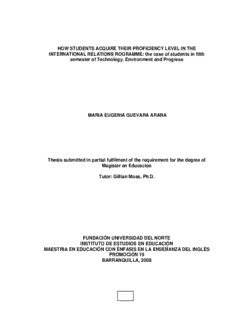
HOW STUDENTS ACQUIRE THEIR PROFICIENCY LEVEL IN THE INTERNATIONAL RELATIONS PDF
Preview HOW STUDENTS ACQUIRE THEIR PROFICIENCY LEVEL IN THE INTERNATIONAL RELATIONS
HOW STUDENTS ACQUIRE THEIR PROFICIENCY LEVEL IN THE INTERNATIONAL RELATIONS ROGRAMME: the case of students in fifth semester of Technology, Environment and Progress MARIA EUGENIA GUEVARA ARANA Thesis submitted in partial fulfilment of the requirement for the degree of Magíster en Educación Tutor: Gillian Moss, Ph.D. FUNDACIÓN UNIVERSIDAD DEL NORTE INSTITUTO DE ESTUDIOS EN EDUCACIÓN MAESTRIA EN EDUCACIÓN CON ÉNFASIS EN LA ENSEÑANZA DEL INGLÉS PROMOCIÓN 19 BARRANQUILLA, 2008 1 Nota de aceptación __________________________________ _________________________ Presidente del Jurado _____________________________ Jurado _____________________________ Jurado Barranquilla, 2008 2 To my wonderful and precious son, Diego, who was always there giving me his time. To my tender and supportive friend, Laster, who was always encouraging me to continue. To my tutor, Dr. Gillian Moss, who was very patient and an excellent motivator To my almighty wonder God, You guided me and showed me the path. “Treat people the way you want to be treated” 3 CONTENT Pages INTRODUCTION 9 1. RATIONALE 11 2. RESEARCH QUESTIONS 13 2.1 Main question 13 2.2 Sub questions 13 3. OBJECTIVES 14 3.1 General Objective 14 3.2 Specific Objectives 14 4. THEORETICAL FRAMEWORK 15 4.1 What Is content based instruction? 16 4.2 Where Is CBI used? 19 4.3 Features of CBI 20 4.3.1 Role of the teacher 22 4.3.2 Role of the learner 23 4.3.3 Role of Materials 23 4.4 Proficiency 25 4.5 Factors affecting Second language Acquisition (SLA) 27 4.5.1 The Monitor Theory 25 4.5.2 Motivation and attitudes 29 4.5.3 Learner preferences and beliefs 31 4.5.4 Age of acquisition 33 4.5.5 Cognitive ability 34 4.6 Learning strategies 37 4.6.1 Cognitive strategies 37 4.6.2 Metacognitives Strategies 37 4 4.6.3 Social/Affective Strategies 38 4.7 Theories behind CBI 39 4.7.1 Krashen‘s comprehensible Input hypothesis 39 4.7.2 Cummins‘ two-tiered skill model 39 4.7.3 Cognitive learning Theory 40 4.8 Theories of CBI behind IRP 40 4.8.1 View of language 41 4.8.1.1 Discourse approach 41 4.8.1.2 Functional approach to language 49 4.8.1.2.1 Advantages of functional approach to language 50 4.8.1.3 Skills Integration 51 4.8.1.4 Communicative competence 52 4.8.2 View of education 53 4.8.2.1 Student-centred approach 53 4.8.2.2 Cooperative and collaborative learning 55 4.8.3 View of learning 56 4.8.3.1 Acknowledgement of learner‘s background 56 4.8.3.2 Acknowledgement of differences in styles 58 5. METHODOLOGY 59 5.1 Research paradigms 59 5.1.1 Quantitative research 60 5.1.2 Qualitative research 61 5.1.3 Ethnography 62 5.2 The Participants 65 5.3 Data Collection procedures 67 5.3.1 Triangulation 68 5.3.2 Interviews 69 5.3.3 Observations 70 5.3.4 Questionnaires 71 6. DEFINITION OF CATEGORIES 72 5 6.1 Motivation 72 6.1.1 High motivation 72 6.1.1. Reason 73 6.1.1.1.1 Variety of methodology 73 6.1.1.1.2 Variety of media 73 6.1.1.1.3 Interesting topics 74 6.1.1.1.4 Functional approach 74 6.1.1.1.5 Essay writing 74 6.2 Proficiency 74 6.2.1 Skills improved 75 6.2.1.1 Vocabulary 75 6.2.1.2 Speaking 75 6.2.1.3 Writing 76 6.2.1.4 Critical reading 76 6.3. Other competences 77 6.3.1 Cultural competences 78 6.4. Importance of content/applicability 78 6.4.1 Topics related to other subjects 78 6.4.2 Useful documents and Information 79 6.5 Student Interaction with Input and output material 80 6.5.1 Interaction with input material 80 6.5.1.1 Silent reading of text 80 6.5.1.2 Reading aloud 81 6.5.1.3 Recognizing participants 82 6.5.1.4 Recognizing genre 82 6.5.1.5 Understanding Ideas 83 6.5.1.6 Word association 83 6.5.1.7 Raising awareness of discourse 84 6.5.1.8 Asking for vocabulary 85 6.5.1.9 Drawing conclusion 85 6 6.5.2 Interaction with output material 86 6.5.2.1 Reading Aloud 86 6.5.2.2 Giving personal opinions 86 6.5.2.3 Refers to cultural context 87 6.5.2.4 Drawing conclusion 87 6.5.2.5 Oral presentation 88 6.5.2.6 Scaffolding 92 6.6 Teacher categories 92 6.6.1 Scaffolding 93 6.6.2 Raising awareness of discourse 93 6.6.3 Raising awareness of appraisal 94 6.6.4 Raising critical awareness 95 6.6.5 Activating prior knowledge 96 6.6.6 Teaching vocabulary 97 6.6.7 Giving examples To Facilitate meaningful learning 98 6.6.8 Applicability to writing 99 6.6.9 Drawing conclusion 100 6.7 Summary of results 103 7. ANALYSIS AND INTERPRETATION OF RESULTS 102 7.1 Description of results 102 7.1.1 Questionnaires 102 7.1.2 Observations 114 7.1.3 Interviews 116 7.1.4 Triangulation 117 8. CONCLUSIONS 121 9. REFERENCES 125 10. APPENDICES 135 7 APPENDICES Pages APPENDIX A: STUDENTS‘ QUESTIONNAIRES 136 APPENDIX B: RESULTS FROM QUESTIONNAIRES 140 APPENDIX C: OBSERVATIONS 149 APPENDIX D: ACTIVITIES FROM TEACHER 200 APPENDIX E: INDIVIDUAL INTERVIEW GUIDE 217 APPENDIX F: INTERVIEWS 218 APPENDIX G: ACTIVITIES FROM STUDENTS 222 8 INTRODUCTION The purpose of this research is to analyze how the methodology in content-based curriculum develops student‘s language proficiency in fifth semester students of the International Relations Programme (IRP) at Universidad Del Norte. It is a relatively new programme which has not yet been evaluated. According to the tutor Moss, (2007) ―results are very positive but we don‘t really know how they are achieved‖. Based on this quote and a suggestion by her I started this research with great enthusiasm and with the conviction that this program is educating a special type of citizen which develops different kinds of competences according to the new political-economical phenomena of this millennium society. On the other hand, IRP has become a career in great demand in our society and I consider that the purpose of this profession here at Universidad del Norte gives students the opportunity to develop in different fields such as politics, embassy, and become leaders of important projects. At first the question or problem is presented. In this section, a general overview of the background of IRP is announced. 9 Then the state of art that support the research is expounded. Afterwards, the selected methodology is explained to develop the research, and the collected data is shown. Having looked at the theoretical issues, and collected data, the results are then analyzed, interpreted and described in order to drawn some conclusions of the research. 10
Description: